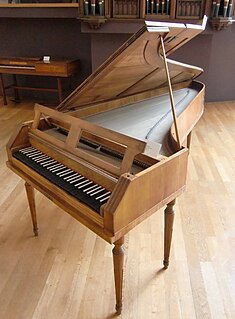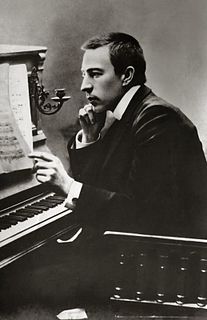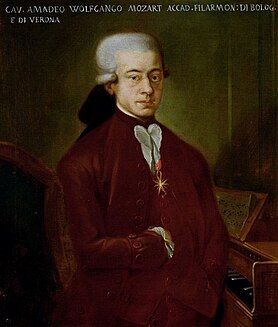External links
- Piano Concerto in A minor : Scores at the International Music Score Library Project (IMSLP)
| This article about a concerto is a stub. You can help Wikipedia by expanding it. |
The Piano Concerto in A minor by Ottorino Respighi is a concerto for piano and orchestra written in 1902 and published in 1941. The work takes around 20 minutes to perform.
The concerto is in three movements:
The concerto is scored for piano, pairs of flutes, oboes, clarinets in B♭, bassoons, horns in F, trumpets in B♭, and timpani and strings.
| This article about a concerto is a stub. You can help Wikipedia by expanding it. |
The Piano Concerto in A minor, Op. 16, composed by Edvard Grieg in 1868, was the only concerto Grieg completed. It is one of his most popular works and is among the most popular of all piano concerti.

The Piano Concerto No. 2 in B♭ major, Op. 83, by Johannes Brahms is separated by a gap of 22 years from his first piano concerto. Brahms began work on the piece in 1878 and completed it in 1881 while in Pressbaum near Vienna. It is dedicated to his teacher, Eduard Marxsen. The public premiere of the concerto was given in Budapest on 9 November 1881, with Brahms as soloist and the Budapest Philharmonic Orchestra, and was an immediate success. He proceeded to perform the piece in many cities across Europe.
The Piano Concerto No. 3 in D minor, Op. 30, composed in 1909 by Sergei Rachmaninoff, has the reputation of being one of the most technically challenging piano concertos in the standard classical repertoire.

The Piano Concerto No. 3 in C minor, Op. 37 is generally thought to have been composed in 1800, although the year of its composition has been questioned by some contemporary musicologists. It was first performed on 5 April 1803, with the composer as soloist. During that same performance, the Second Symphony and the oratorio Christ on the Mount of Olives were also premiered. The composition was published in 1804, and was dedicated to Prince Louis Ferdinand of Prussia. The first primary theme is reminiscent of that of Mozart's 24th Piano Concerto.
Franz Xaver Scharwenka was a German pianist, composer and teacher of Bohemian-Polish descent. He was the brother of Ludwig Philipp Scharwenka (1847–1917), who was also a composer and teacher of music.

The Piano Concerto No. 20 in D minor, K. 466, was composed by Wolfgang Amadeus Mozart in 1785. The first performance took place at the Mehlgrube Casino in Vienna on 11 February 1785, with the composer as the soloist.

Carl Heinrich Carsten Reinecke was a German composer, conductor, and pianist in the Middle Romantic Era.

The Piano Concerto No. 2 in C minor, Op. 18, is a concerto for piano and orchestra composed by Sergei Rachmaninoff between the autumn of 1900 and April 1901. The second and third movements were first performed with the composer as soloist on 2 December 1900. The complete work was premiered, again with the composer as soloist, on 9 November 1901, with his cousin Alexander Siloti conducting.

Ludwig van Beethoven's Piano Concerto No. 4 in G major, Op. 58, was composed in 1805–1806. Beethoven was the soloist in the public premiere as part of the concert on 22 December 1808 at Vienna's Theater an der Wien.

The Piano Concerto No. 21 in C major, K. 467, was completed on 9 March 1785 by Wolfgang Amadeus Mozart, four weeks after the completion of the previous D minor concerto, K. 466.

In music theory, B-flat major is a major scale based on B♭, with pitches B♭, C, D, E♭, F, G, and A. Its key signature has two flats. Its relative minor is G minor and its parallel minor is B-flat minor.

D-flat major is a major scale based on D♭, consisting of the pitches D♭, E♭, F, G♭, A♭, B♭ and C. It is enharmonically equivalent to C-sharp major. Its key signature has five flats.

D minor is a minor scale based on D, consisting of the pitches D, E, F, G, A, B♭, and C. Its key signature has one flat. Its relative major is F major and its parallel major is D major.

A minor is a minor scale based on A, with the pitches A, B, C, D, E, F, and G. Its key signature has no flats and no sharps. Its relative major is C major and its parallel major is A major.

B-flat minor is a minor scale based on B♭, consisting of the pitches B♭, C, D♭, E♭, F, G♭, and A♭. Its key signature has five flats. Its relative major is D-flat major and its parallel major is B-flat major. Its enharmonic equivalent, A-sharp minor, which would contain seven sharps, is not normally used.

The Piano Concerto No. 27 in B♭ major, K. 595, is Wolfgang Amadeus Mozart's last piano concerto; it was first performed early in 1791, the year of his death.

The Concerto for Piano and Orchestra in G minor, Op. 33, is the only piano concerto by Czech composer Antonín Dvořák. Written in 1876, it was the first of three concertos that Dvořák completed, followed by the Violin Concerto, Op. 53 from 1879 and the Cello Concerto, Op. 104, written in 1894–1895. The piano concerto is probably the least known and least performed of Dvořák's concertos.

The Piano Concerto No. 14, K. 449, in E♭ major by Wolfgang Amadeus Mozart, written in 1784, is a piano concerto.

The Piano Concerto No. 6 in B-flat major, K. 238, was composed by Wolfgang Amadeus Mozart in January 1776. His Concerto No. 7 for three pianos and his Concerto No. 8 in C major would follow within three months. The three works share what Cuthbert Girdlestone refers to as a galant style.

The Piano Concerto No. 2 in D minor, Op. 40, was written in 1837 by Felix Mendelssohn and premiered at the Birmingham Festival that year, an event that also saw the premier of Mendelssohn's oratorio St. Paul. He had already written a piano concerto in A minor with string accompaniment (1822), two concertos with two pianos (1823–4), and his first Piano Concerto. The concerto is about 25 minutes in length, and is scored for solo piano, 2 flutes, 2 oboes, 2 clarinets, 2 bassoons, 2 horns, 2 trumpets, timpani, and strings.